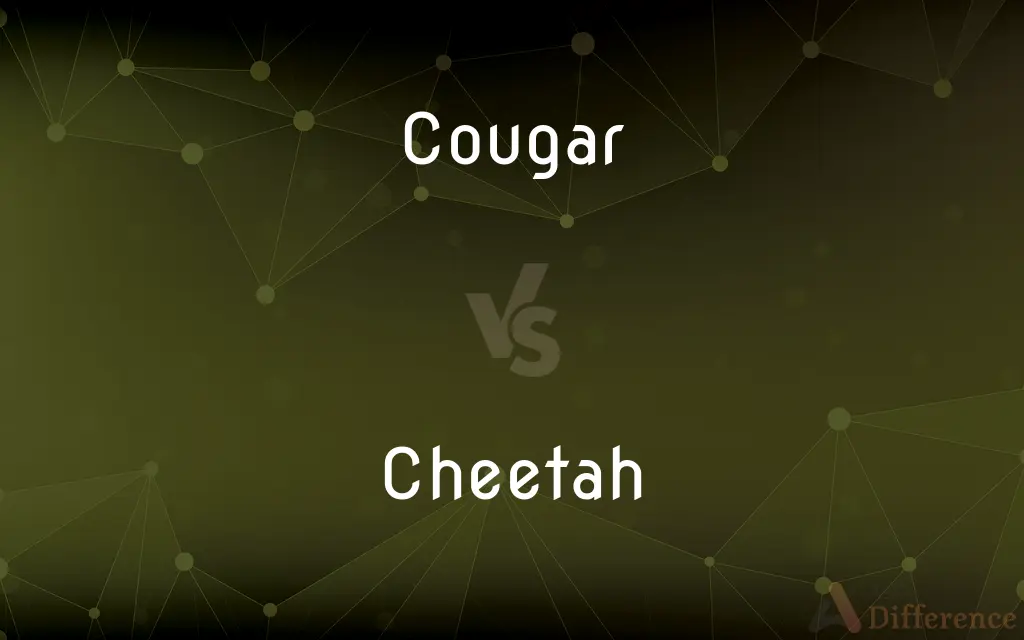Cougar vs. Cheetah — What's the Difference?
By Tayyaba Rehman & Fiza Rafique — Updated on April 5, 2024
A cougar is a large, solitary cat known for its strength and ability to climb, found primarily in the Americas. A cheetah, the fastest land animal, is recognized for its incredible speed and agility, mainly found in Africa and parts of Iran.

Difference Between Cougar and Cheetah
Table of Contents
ADVERTISEMENT
Key Differences
Cougars, also known as mountain lions or pumas, are notable for their adaptability to various habitats across the Americas. Cheetahs, on the other hand, are distinct for their slender bodies and long legs, adaptations that enable their remarkable speed, reaching up to 75 mph in short bursts covering distances up to 1,500 feet.
While cougars are solitary hunters that rely on stealth and strength, cheetahs use their incredible speed and agility to chase down prey in the open savannah. Cougars can climb trees and prefer to ambush their prey from above or stalk them silently, whereas cheetahs need vast open spaces where they can accelerate to catch their prey before it can escape.
The habitats of cougars and cheetahs also highlight their differences. Cougars are versatile in their habitat choices, living in forests, mountain regions, and even urban fringes. In contrast, cheetahs are more specialized, requiring large expanses of open land where they can utilize their speed, which makes them more vulnerable to habitat loss.
In terms of social structure, cougars are mostly solitary, coming together only for mating. Cheetahs, especially males, are known to form small groups called coalitions, which help them defend territories and increase their chances of finding a mate. This social behavior is unusual among large cats and is a distinctive feature of cheetahs.
Comparison Chart
Habitat
Americas, from forests to deserts.
Africa and parts of Iran, open savannahs.
ADVERTISEMENT
Physical Traits
Strong, capable climbers, solid tan coat.
Slender body, long legs, black spots, and tear-stripes.
Hunting Strategy
Ambush or stalk prey, can climb trees.
Incredible speed and agility in open spaces.
Speed
Less known for speed, more for strength.
Up to 75 mph in short bursts.
Social Structure
Solitary, except during mating.
Males often form coalitions; less solitary.
Compare with Definitions
Cougar
A large, solitary cat known for its strength and adaptability to various habitats.
The cougar is one of the top predators in the American forests.
Cheetah
The fastest land animal, capable of reaching speeds up to 75 mph.
The cheetah chased down the gazelle with incredible speed.
Cougar
Primarily found in the Americas.
Cougars range from the Canadian Yukon to the southern Andes.
Cheetah
Hunts primarily during the day, using speed to catch prey.
Cheetahs exploit their daytime hunting to avoid competition with larger nocturnal predators.
Cougar
Capable of taking down larger prey due to its power.
Cougars can prey on deer and even elk.
Cheetah
Forms coalitions among males for territory defense.
Male cheetahs form coalitions to defend their territory and secure mating rights.
Cougar
Excellent climber, using trees for ambush.
Cougars often use their climbing ability to ambush prey from above.
Cheetah
Recognized by its slender body, long legs, and distinctive spots.
The cheetah's spots help camouflage it in the grassy savannah.
Cougar
Solitary except for mating, with a broad diet.
Cougars have a diverse diet, feeding on everything from insects to large ungulates.
Cheetah
Found mainly in Africa and parts of Iran.
Cheetahs are primarily spotted in the savannahs of sub-Saharan Africa.
Cougar
The cougar (Puma concolor) is a large cat of the subfamily Felinae. Native to the Americas, its range spans from the Canadian Yukon to the southern Andes in South America and is the most widespread of any large wild terrestrial mammal in the Western Hemisphere.
Cheetah
The cheetah (Acinonyx jubatus) is a large cat native to Africa and central Iran. It is the fastest land animal, estimated to be capable of running at 80 to 128 km/h (50 to 80 mph) with the fastest reliably recorded speeds being 93 and 98 km/h (58 and 61 mph), and as such has several adaptations for speed, including a light build, long thin legs and a long tail.
Cougar
A large powerful wild cat (Puma concolor syn. Felis concolor) chiefly of mountainous regions of the Americas, having an unmarked tawny body and a long tail. Also called catamount, mountain cat, mountain lion, panther, puma; Also called regionally painter.
Cheetah
A long-legged, swift-running wild cat (Acinonyx jubatus) of Africa and southwest Asia, having tawny, black-spotted fur and nonretractile claws. The cheetah, the fastest animal on land, can run for short distances at about 96 kilometers (60 miles) per hour.
Cougar
(Slang) A woman, especially one over 30, who romantically pursues or attracts younger men.
Cheetah
A distinctive member (Acinonyx jubatus) of the cat family, slightly smaller than the leopard, but with proportionately longer limbs and a smaller head; native to Africa and southeast Asia (where it is nearly extinct) and also credited with being the fastest terrestrial animal.
Cougar
Puma concolor, a wild feline native to the Americas.
Florida panther
Cheetah
A species of leopard (Cynælurus jubatus) tamed and used for hunting in India. The woolly cheetah of South Africa is Cynælurus laneus. It runs very fast in short spurts while hunting.
Cougar
An American feline quadruped (Felis concolor), resembling the African panther in size and habits. Its color is tawny, without spots; hence writers often called it the American lion. Called also puma, panther, mountain lion, and catamount. See Puma.
Cheetah
Long-legged spotted cat of Africa and southwestern Asia having nonretractile claws; the swiftest mammal; can be trained to run down game
Cougar
Large American feline resembling a lion
Common Curiosities
What challenges do cheetahs face in the wild?
Cheetahs face several challenges, including habitat loss, conflict with humans, poaching, and competition with larger predators for food.
Can cougars and cheetahs be found in the same habitat?
No, cougars and cheetahs inhabit different continents and ecosystems, with cougars in the Americas and cheetahs in Africa and parts of Iran.
Why can't cheetahs maintain their top speed for long distances?
Cheetahs cannot maintain their top speed for long due to the immense energy required and the risk of overheating. Their hunting strategy relies on short, explosive bursts of speed to catch prey quickly.
How do cougars communicate with each other?
Cougars communicate through visual and olfactory signals, as well as vocalizations like growls, hisses, and purrs, especially during mating seasons or territorial disputes.
Why are cheetahs considered vulnerable to extinction?
Cheetahs are considered vulnerable due to a combination of factors, including habitat loss, reduced prey availability, genetic bottlenecking, and human-wildlife conflict.
How do conservation efforts differ for cougars and cheetahs?
Conservation efforts for cougars often focus on habitat preservation and reducing human-wildlife conflict, while cheetah conservation includes protecting genetic diversity and increasing their habitat range.
How do cougars and cheetahs raise their young?
Both cougars and cheetahs raise their young in secluded dens or hiding spots. Cougar and cheetah mothers are solely responsible for teaching their offspring to hunt and survive.
What adaptations do cheetahs have for high-speed chases?
Cheetahs have several adaptations for speed, including a lightweight frame, long legs, non-retractable claws for traction, and a long tail for balance during high-speed chases.
How do cougars contribute to ecosystem balance?
As apex predators, cougars help control the population of herbivores, contributing to the balance of ecosystems by preventing overgrazing.
Do cougars have any natural predators?
Adult cougars have few natural predators and are top predators in their environment, though they may compete with other large predators like bears and packs of wolves.
Share Your Discovery

Previous Comparison
Arquebus vs. Musket
Next Comparison
Diadem vs. CrownAuthor Spotlight
Written by
Tayyaba RehmanTayyaba Rehman is a distinguished writer, currently serving as a primary contributor to askdifference.com. As a researcher in semantics and etymology, Tayyaba's passion for the complexity of languages and their distinctions has found a perfect home on the platform. Tayyaba delves into the intricacies of language, distinguishing between commonly confused words and phrases, thereby providing clarity for readers worldwide.
Co-written by
Fiza RafiqueFiza Rafique is a skilled content writer at AskDifference.com, where she meticulously refines and enhances written pieces. Drawing from her vast editorial expertise, Fiza ensures clarity, accuracy, and precision in every article. Passionate about language, she continually seeks to elevate the quality of content for readers worldwide.














































